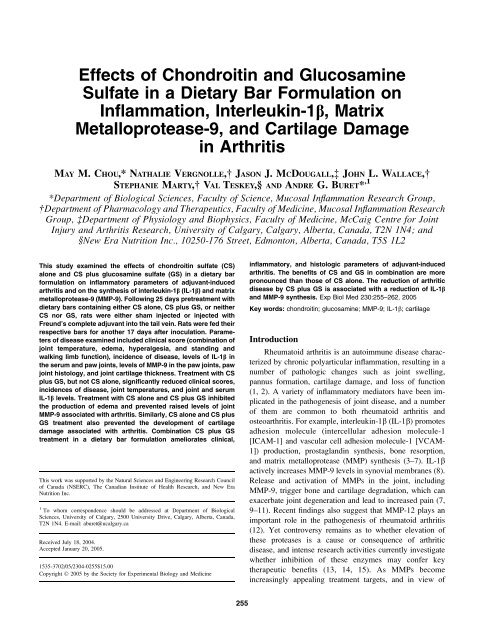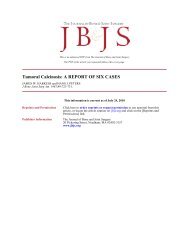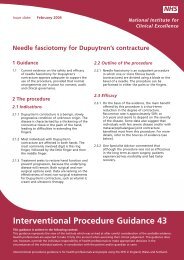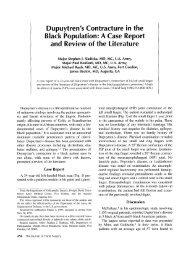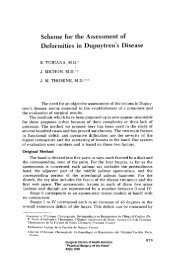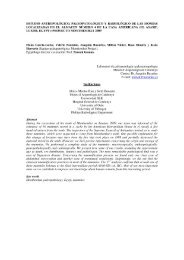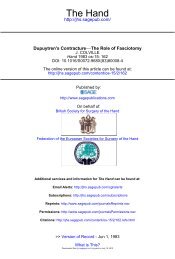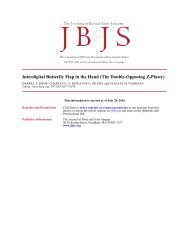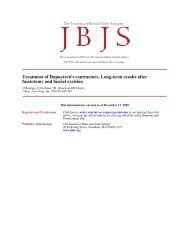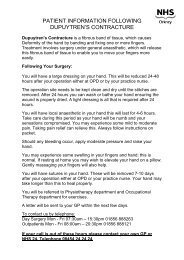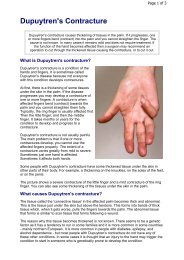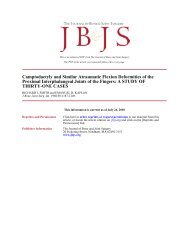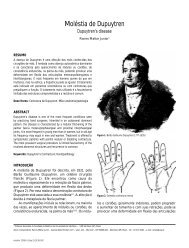Effects of Chondroitin and Glucosamine Sulfate in a Dietary Bar ...
Effects of Chondroitin and Glucosamine Sulfate in a Dietary Bar ...
Effects of Chondroitin and Glucosamine Sulfate in a Dietary Bar ...
Create successful ePaper yourself
Turn your PDF publications into a flip-book with our unique Google optimized e-Paper software.
<strong>Effects</strong> <strong>of</strong> <strong>Chondroit<strong>in</strong></strong> <strong>and</strong> <strong>Glucosam<strong>in</strong>e</strong><strong>Sulfate</strong> <strong>in</strong> a <strong>Dietary</strong> <strong>Bar</strong> Formulation onInflammation, Interleuk<strong>in</strong>-1b, MatrixMetalloprotease-9, <strong>and</strong> Cartilage Damage<strong>in</strong> ArthritisMAY M. CHOU,* NATHALIE VERGNOLLE, JASON J. MCDOUGALL,à JOHN L. WALLACE,STEPHANIE MARTY, VAL TESKEY,§ AND ANDRE G. BURET* ,1*Department <strong>of</strong> Biological Sciences, Faculty <strong>of</strong> Science, Mucosal Inflammation Research Group,Department <strong>of</strong> Pharmacology <strong>and</strong> Therapeutics, Faculty <strong>of</strong> Medic<strong>in</strong>e, Mucosal Inflammation ResearchGroup, àDepartment <strong>of</strong> Physiology <strong>and</strong> Biophysics, Faculty <strong>of</strong> Medic<strong>in</strong>e, McCaig Centre for Jo<strong>in</strong>tInjury <strong>and</strong> Arthritis Research, University <strong>of</strong> Calgary, Calgary, Alberta, Canada, T2N 1N4; <strong>and</strong>§New Era Nutrition Inc., 10250-176 Street, Edmonton, Alberta, Canada, T5S 1L2This study exam<strong>in</strong>ed the effects <strong>of</strong> chondroit<strong>in</strong> sulfate (CS)alone <strong>and</strong> CS plus glucosam<strong>in</strong>e sulfate (GS) <strong>in</strong> a dietary barformulation on <strong>in</strong>flammatory parameters <strong>of</strong> adjuvant-<strong>in</strong>ducedarthritis <strong>and</strong> on the synthesis <strong>of</strong> <strong>in</strong>terleuk<strong>in</strong>-1b (IL-1b) <strong>and</strong> matrixmetalloprotease-9 (MMP-9). Follow<strong>in</strong>g 25 days pretreatment withdietary bars conta<strong>in</strong><strong>in</strong>g either CS alone, CS plus GS, or neitherCS nor GS, rats were either sham <strong>in</strong>jected or <strong>in</strong>jected withFreund’s complete adjuvant <strong>in</strong>to the tail ve<strong>in</strong>. Rats were fed theirrespective bars for another 17 days after <strong>in</strong>oculation. Parameters<strong>of</strong> disease exam<strong>in</strong>ed <strong>in</strong>cluded cl<strong>in</strong>ical score (comb<strong>in</strong>ation <strong>of</strong>jo<strong>in</strong>t temperature, edema, hyperalgesia, <strong>and</strong> st<strong>and</strong><strong>in</strong>g <strong>and</strong>walk<strong>in</strong>g limb function), <strong>in</strong>cidence <strong>of</strong> disease, levels <strong>of</strong> IL-1b <strong>in</strong>the serum <strong>and</strong> paw jo<strong>in</strong>ts, levels <strong>of</strong> MMP-9 <strong>in</strong> the paw jo<strong>in</strong>ts, pawjo<strong>in</strong>t histology, <strong>and</strong> jo<strong>in</strong>t cartilage thickness. Treatment with CSplus GS, but not CS alone, significantly reduced cl<strong>in</strong>ical scores,<strong>in</strong>cidences <strong>of</strong> disease, jo<strong>in</strong>t temperatures, <strong>and</strong> jo<strong>in</strong>t <strong>and</strong> serumIL-1b levels. Treatment with CS alone <strong>and</strong> CS plus GS <strong>in</strong>hibitedthe production <strong>of</strong> edema <strong>and</strong> prevented raised levels <strong>of</strong> jo<strong>in</strong>tMMP-9 associated with arthritis. Similarly, CS alone <strong>and</strong> CS plusGS treatment also prevented the development <strong>of</strong> cartilagedamage associated with arthritis. Comb<strong>in</strong>ation CS plus GStreatment <strong>in</strong> a dietary bar formulation ameliorates cl<strong>in</strong>ical,This work was supported by the Natural Sciences <strong>and</strong> Eng<strong>in</strong>eer<strong>in</strong>g Research Council<strong>of</strong> Canada (NSERC), The Canadian Institute <strong>of</strong> Health Research, <strong>and</strong> New EraNutrition Inc.1 To whom correspondence should be addressed at Department <strong>of</strong> BiologicalSciences, University <strong>of</strong> Calgary, 2500 University Drive, Calgary, Alberta, Canada,T2N 1N4. E-mail: aburet@ucalgary.caReceived July 18, 2004.Accepted January 20, 2005.1535-3702/05/2304-0255$15.00Copyright Ó 2005 by the Society for Experimental Biology <strong>and</strong> Medic<strong>in</strong>e<strong>in</strong>flammatory, <strong>and</strong> histologic parameters <strong>of</strong> adjuvant-<strong>in</strong>ducedarthritis. The benefits <strong>of</strong> CS <strong>and</strong> GS <strong>in</strong> comb<strong>in</strong>ation are morepronounced than those <strong>of</strong> CS alone. The reduction <strong>of</strong> arthriticdisease by CS plus GS is associated with a reduction <strong>of</strong> IL-1b<strong>and</strong> MMP-9 synthesis. Exp Biol Med 230:255–262, 2005Key words: chondroit<strong>in</strong>; glucosam<strong>in</strong>e; MMP-9; IL-1b; cartilageIntroductionRheumatoid arthritis is an autoimmune disease characterizedby chronic polyarticular <strong>in</strong>flammation, result<strong>in</strong>g <strong>in</strong> anumber <strong>of</strong> pathologic changes such as jo<strong>in</strong>t swell<strong>in</strong>g,pannus formation, cartilage damage, <strong>and</strong> loss <strong>of</strong> function(1, 2). A variety <strong>of</strong> <strong>in</strong>flammatory mediators have been implicated<strong>in</strong> the pathogenesis <strong>of</strong> jo<strong>in</strong>t disease, <strong>and</strong> a number<strong>of</strong> them are common to both rheumatoid arthritis <strong>and</strong>osteoarthritis. For example, <strong>in</strong>terleuk<strong>in</strong>-1b (IL-1b) promotesadhesion molecule (<strong>in</strong>tercellular adhesion molecule-1[ICAM-1] <strong>and</strong> vascular cell adhesion molecule-1 [VCAM-1]) production, prostagl<strong>and</strong><strong>in</strong> synthesis, bone resorption,<strong>and</strong> matrix metalloprotease (MMP) synthesis (3–7). IL-1bactively <strong>in</strong>creases MMP-9 levels <strong>in</strong> synovial membranes (8).Release <strong>and</strong> activation <strong>of</strong> MMPs <strong>in</strong> the jo<strong>in</strong>t, <strong>in</strong>clud<strong>in</strong>gMMP-9, trigger bone <strong>and</strong> cartilage degradation, which canexacerbate jo<strong>in</strong>t degeneration <strong>and</strong> lead to <strong>in</strong>creased pa<strong>in</strong> (7,9–11). Recent f<strong>in</strong>d<strong>in</strong>gs also suggest that MMP-12 plays animportant role <strong>in</strong> the pathogenesis <strong>of</strong> rheumatoid arthritis(12). Yet controversy rema<strong>in</strong>s as to whether elevation <strong>of</strong>these proteases is a cause or consequence <strong>of</strong> arthriticdisease, <strong>and</strong> <strong>in</strong>tense research activities currently <strong>in</strong>vestigatewhether <strong>in</strong>hibition <strong>of</strong> these enzymes may confer keytherapeutic benefits (13, 14, 15). As MMPs become<strong>in</strong>creas<strong>in</strong>gly appeal<strong>in</strong>g treatment targets, <strong>and</strong> <strong>in</strong> view <strong>of</strong>255
CHONDROITIN AND GLUCOSAMINE SULFATE BAR 257greater than 90% pure dry weight; OptaFlex, Cargill Health<strong>and</strong> Food Technologies, High River, Canada) was mixed <strong>in</strong>New Era’s bar formulation to a f<strong>in</strong>al concentration <strong>of</strong> 18 mgCS/g bar. In bars conta<strong>in</strong><strong>in</strong>g CS <strong>and</strong> GS together, GS (H&A,Toronto, Canada), at a f<strong>in</strong>al concentration <strong>of</strong> 22.5 mg GS/gbar, <strong>in</strong> addition to CS (18 mg CS/g bar) (Cargill), was mixed<strong>in</strong>to New Era’s bar formulation. In this study, the GS usedwas a glucosam<strong>in</strong>e preparation conta<strong>in</strong><strong>in</strong>g sulfate cocrystallizedwith potassium (D-glucosam<strong>in</strong>e sulfate, potassiumsalt). Based on prelim<strong>in</strong>ary experiments, calculations <strong>of</strong> theamount <strong>of</strong> CS <strong>and</strong> GS <strong>in</strong> bars were based on an averageconsumption <strong>of</strong> 20 g <strong>of</strong> bar per rat per day <strong>and</strong> an averagerat body weight <strong>of</strong> 300 g. S<strong>in</strong>ce the body weight <strong>of</strong> the ratsranged from 150 to 500 g over the course <strong>of</strong> the study, thedoses <strong>of</strong> CS <strong>and</strong> GS were calculated based on averagebody weight throughout the whole study. Selected doses <strong>of</strong>CS (1.2 g/kg/day) <strong>and</strong> GS (1.5 g/kg/day) were consistentwith those previously established for experiments <strong>in</strong> rats(27, 38–41). Rats were fed bars for 25 days before sham<strong>in</strong>jection or immunization with Freund’s complete adjuvant,<strong>and</strong> then for an additional 17 days after <strong>in</strong>oculation.Arthritis Induction. Rats from Groups 2–4 wereimmunized <strong>in</strong> the base <strong>of</strong> the tail with 150 ll <strong>of</strong> 7.5 mg/mlattenuated Mycobacterium butyricum (Difco, Mississauga,Canada) emulsified <strong>in</strong> Freund’s complete adjuvant (Difco),as previously established (38, 42, 43). Rats from Group 1were <strong>in</strong>jected with 150 ll PBS <strong>in</strong>tradermally through eachside <strong>of</strong> the base <strong>of</strong> the tail. Rats were sacrificed with an<strong>in</strong>traperitoneal overdose <strong>of</strong> sodium pentobarbital 17 daysfollow<strong>in</strong>g immunization, <strong>and</strong> samples were collected asoutl<strong>in</strong>ed below.Cl<strong>in</strong>ical Score <strong>and</strong> Incidence <strong>of</strong> Arthritic Disease.Cl<strong>in</strong>ical symptoms <strong>of</strong> arthritis were assessed Day 17after sham or Freund’s complete adjuvant <strong>in</strong>jection <strong>and</strong>scored on a scale from 0 to 4 based on four criteria, eachworth one po<strong>in</strong>t. In an attempt to closely reflect the card<strong>in</strong>alsigns <strong>of</strong> <strong>in</strong>flammation, the four criteria consisted <strong>of</strong> (i) heat,jo<strong>in</strong>t temperature .32.08C; (ii) edema, paw volume .2.70ml; (iii) hyperalgesia, withdrawal latency ,5.0 secs; <strong>and</strong>(iv) st<strong>and</strong><strong>in</strong>g <strong>and</strong> walk<strong>in</strong>g limb function, paw lift<strong>in</strong>g,limp<strong>in</strong>g. Criteria were assessed accord<strong>in</strong>g to proceduresoutl<strong>in</strong>ed below, us<strong>in</strong>g protocols that have been previouslyvalidated (38, 44–47). Rats exhibit<strong>in</strong>g one or more <strong>of</strong> thefour above criteria for cl<strong>in</strong>ical scores were considered tohave a positive cl<strong>in</strong>ical score. Incidence <strong>of</strong> arthritic diseasewas calculated <strong>and</strong> expressed as the percentage <strong>of</strong> rats <strong>in</strong>each treatment group with a positive cl<strong>in</strong>ical score overtime.Jo<strong>in</strong>t Temperature. Rats were lightly anesthetizedwith 5% halothane, <strong>and</strong> a blunt needle thermocouple digitalthermometer (Doric Scientific, San Diego, CA) was appliedtopically <strong>and</strong> nestled onto the right ankle jo<strong>in</strong>t <strong>of</strong> each rat.Jo<strong>in</strong>t temperatures were recorded on Day 17 after <strong>in</strong>jection.Ambient temperature was ma<strong>in</strong>ta<strong>in</strong>ed at 228C.Paw Volume. Paw volume was measured us<strong>in</strong>g afluid displacement plethysmometer (Kent Scientific, Torr<strong>in</strong>gton,CT) as previously described (38, 39). The right h<strong>in</strong>dpaw <strong>of</strong> each rat was immersed <strong>in</strong> the plethysmometer, <strong>and</strong>the paw volume was recorded on Day 17 after <strong>in</strong>jection.Hyperalgesia. Hyperalgesia <strong>in</strong> response to a radiantheat stimulus <strong>in</strong> each rat’s paw was assessed us<strong>in</strong>g theplantar test apparatus (Harvard Apparatus, Holliston, MA)as previously described (46, 47). A light source was placedbeneath the plantar surface <strong>of</strong> the right h<strong>in</strong>d paw <strong>of</strong> each rat<strong>and</strong> turned on. As the <strong>in</strong>tensity <strong>of</strong> the light <strong>in</strong>creased overtime, the rat would withdraw its paw away from the source<strong>of</strong> light. The withdrawal latency time <strong>of</strong> the rat <strong>in</strong> responseto the thermal stimulus (i.e., the time between when the lightwas turned on <strong>and</strong> the time when the rat withdrew its paw)was automatically recorded. Withdrawal latency times wererecorded on Day 17 after <strong>in</strong>jection.Cytok<strong>in</strong>e (IL-1b) <strong>and</strong> Protease (MMP-9) Levels.On Day 17 after <strong>in</strong>jection, right ankle jo<strong>in</strong>ts were collected(adjacent to both sides <strong>of</strong> the jo<strong>in</strong>t capsule), sk<strong>in</strong>ned,stripped <strong>of</strong> the s<strong>of</strong>t tissue, snap frozen <strong>in</strong> liquid nitrogen, <strong>and</strong>stored at 808C. Frozen jo<strong>in</strong>ts were milled with bonecutters, homogenized <strong>in</strong> 2 ml <strong>of</strong> PBS (<strong>in</strong> an attempt tomaximize cytok<strong>in</strong>e <strong>and</strong> MMP recovery), <strong>and</strong> centrifuged at800 g for 20 m<strong>in</strong>s. The supernatants (exclud<strong>in</strong>g the top fatlayer) were collected <strong>and</strong> frozen at 808C for measurements<strong>of</strong> IL-1b <strong>and</strong> MMP-9 levels. Levels <strong>of</strong> IL-1b were measuredus<strong>in</strong>g a commercially available enzyme-l<strong>in</strong>ked immunosorbentassay (ELISA) kit (R&D Systems, M<strong>in</strong>neapolis,MN) per manufacturer’s <strong>in</strong>structions. This assay is specificfor both recomb<strong>in</strong>ant <strong>and</strong> natural rat IL-1b <strong>and</strong> has am<strong>in</strong>imum detectable dose <strong>of</strong> less than 5 pg/ml IL-1b. Levels<strong>of</strong> MMP-9 activity were measured us<strong>in</strong>g a commerciallyavailable ELISA kit that recognizes both proenzyme <strong>and</strong>active forms <strong>of</strong> MMP-9 (Amersham Biosciences, Baied’Urfe, Canada), per manufacturer’s <strong>in</strong>structions. This assaycross-reacts with rabbit <strong>and</strong> mouse MMP-9 but does notcross-react with other MMPs. The effective range <strong>of</strong> thisassay was 0.5–16 ng/ml MMP-9. IL-1b <strong>and</strong> MMP-9 weredetected aga<strong>in</strong>st purified st<strong>and</strong>ards <strong>of</strong> the mediators <strong>and</strong>expressed as level (picogram or nanogram, respectively) pergram <strong>of</strong> jo<strong>in</strong>t tissue. In addition, systemic IL-1b levels weremeasured from serum samples collected via cardiacpuncture on Day 17 <strong>and</strong> are expressed as picograms permilliliter <strong>of</strong> serum.Histology. Left ankle jo<strong>in</strong>ts <strong>of</strong> each rat were fixed <strong>in</strong>10% formal<strong>in</strong> (VWR, Edmonton, Canada) for 14 days,decalcified with CalEx decalcification solution (FisherScientific, Nepean, Canada) for 35 days, <strong>and</strong> processed <strong>in</strong>paraff<strong>in</strong> (50:50 Paraplast Plus <strong>and</strong> Paraplast Xtraplus)(VWR). Sections (7 lm) were sta<strong>in</strong>ed with hematoxyl<strong>in</strong>(Fisher Scientific), saffran<strong>in</strong>-O (Fisher Scientific), <strong>and</strong> fastgreen (Fisher Scientific). Average thickness <strong>of</strong> the cartilage,<strong>in</strong>clud<strong>in</strong>g the tangential, transitional, radial, <strong>and</strong> calcifiedcartilage layers, was calculated from three differentmeasurements <strong>in</strong> the apical condyle <strong>of</strong> the tibial bone <strong>and</strong>three different measurements <strong>in</strong> the apical condyle <strong>of</strong> thetarsal bone <strong>in</strong> the tibiotarsal jo<strong>in</strong>t, us<strong>in</strong>g Openlab 3.0.3
258 CHOU ET ALFigure 1. Cl<strong>in</strong>ical scores (based on jo<strong>in</strong>t temperature, edema,hyperalgesia, <strong>and</strong> st<strong>and</strong><strong>in</strong>g <strong>and</strong> walk<strong>in</strong>g limb function) <strong>of</strong> rats 17days after sham or Freund’s complete adjuvant <strong>in</strong>jection. n = 12 pergroup. Rats either were placebo-treated healthy rats or were givenbars conta<strong>in</strong><strong>in</strong>g CS, CS plus GS, or no active compound (control)before <strong>in</strong>jection. Values are mean plus or m<strong>in</strong>us SEM. * P , 0.05versus healthy, # P , 0.05 versus control.s<strong>of</strong>tware (Improvision Ltd., Lex<strong>in</strong>gton, MA) at 1003magnification.Statistical Analyses. Results were expressed asmeans plus or m<strong>in</strong>us st<strong>and</strong>ard error <strong>of</strong> mean (SEM).Statistical significance was evaluated us<strong>in</strong>g one-wayanalysis <strong>of</strong> variance (ANOVA) for parametric data or theKruskal-Wallis nonparametric test, followed by Tukey’smultiple comparison analysis. All calculations were performedus<strong>in</strong>g SigmaStat statistical s<strong>of</strong>tware (SPSS Inc.,Chicago, IL). Values <strong>of</strong> P , 0.05 were consideredstatistically significant.ResultsCl<strong>in</strong>ical Score. Arthritic control rats had a significantlyhigher cl<strong>in</strong>ical score compared with healthy rats(Fig. 1). Arthritic rats treated with CS alone also showed asignificantly (P , 0.05) higher cl<strong>in</strong>ical score than healthyrats. The cl<strong>in</strong>ical score <strong>of</strong> arthritic rats treated with CS plusGS was not different from that <strong>of</strong> healthy rats <strong>and</strong> showed alower cl<strong>in</strong>ical score than the arthritic control group (P ,0.05).Incidence <strong>of</strong> Arthritic Disease. Signs <strong>of</strong> diseasewere first observed 11 days after <strong>in</strong>jection (Fig. 2). Rats<strong>in</strong>jected with Freund’s complete adjuvant <strong>and</strong> treated withplacebo bar (control) had a significantly (P , 0.05) higher<strong>in</strong>cidence <strong>of</strong> arthritic disease than healthy rats 14–17 daysafter <strong>in</strong>jection (Fig. 2). Rats treated with CS plus GS, but notthose given CS alone, had a significantly (P , 0.05) lower<strong>in</strong>cidence <strong>of</strong> disease than arthritic control rats at days 14–16.Disease <strong>in</strong>cidence <strong>in</strong> both the arthritic CS-treated group <strong>and</strong>the arthritic CS plus GS–treated group was not significantlydifferent from that <strong>of</strong> the healthy rats at any time po<strong>in</strong>tdur<strong>in</strong>g the study (Fig. 2).Figure 2. Incidence <strong>of</strong> arthritic disease (percentage <strong>of</strong> rats with oneor more cl<strong>in</strong>ical score criterion [jo<strong>in</strong>t temperature edema, hyperalgesia,st<strong>and</strong><strong>in</strong>g <strong>and</strong> walk<strong>in</strong>g limb function] on each day) <strong>in</strong> rats thateither were placebo-treated healthy rats or were given barsconta<strong>in</strong><strong>in</strong>g CS, CS plus GS, or no active compound (control) before<strong>in</strong>jection. n = 12 for each data po<strong>in</strong>t. Values are mean plus or m<strong>in</strong>usSEM. * P , 0.05 versus healthy, # P , 0.05 versus control.Jo<strong>in</strong>t Temperature. Both arthritic control rats <strong>and</strong>arthritic rats treated with CS had significantly (P , 0.05)higher jo<strong>in</strong>t temperatures than healthy rats (Fig. 3). Ratstreated with CS plus GS had jo<strong>in</strong>t temperatures that weresignificantly (P , 0.05) lower than both the arthritic controlgroup <strong>and</strong> the group treated with CS alone <strong>and</strong> were notdifferent from healthy rats (Fig. 3).Paw Volume. Arthritic control rats had significantly(P , 0.05) higher paw volume than healthy controls (Fig.4). In contrast, paw volume <strong>of</strong> rats treated with CS or CSplus GS was not different from that <strong>of</strong> healthy rats, althoughFigure 3. Jo<strong>in</strong>t temperatures (17 days after <strong>in</strong>jection) <strong>in</strong> rats thateither were placebo-treated healthy rats or were given barsconta<strong>in</strong><strong>in</strong>g CS, CS plus GS, or no active compound (control) before<strong>in</strong>jection. n = 12 per group. Values are mean plus or m<strong>in</strong>us SEM. * P, 0.05 versus healthy, # P , 0.05 versus control, @ P , 0.05versus CS bar.
CHONDROITIN AND GLUCOSAMINE SULFATE BAR 259Figure 4. Paw volumes (17 days after <strong>in</strong>jection) <strong>of</strong> rats that eitherwere placebo-treated healthy rats or were given bars conta<strong>in</strong><strong>in</strong>g CS,CS plus GS, or no active compound (control) before <strong>in</strong>jection. n =12per group. Values are mean plus or m<strong>in</strong>us SEM. * P , 0.05 versushealthy.the values were not statistically lower than those measured<strong>in</strong> arthritic rats either.Hyperalgesia. Healthy rats had a withdrawal latencytime <strong>of</strong> 9.04 6 1.14 secs (mean plus or m<strong>in</strong>us SE), whilegroups <strong>in</strong>jected with Freund’s complete adjuvant (control,CS, <strong>and</strong> CS plus GS groups) had withdrawal latency times<strong>of</strong> 5.98 6 1.14 secs, 7.27 6 0.66 secs, <strong>and</strong> 6.66 6 0.40secs, respectively (data not shown). There were no statisticallysignificant differences among groups.Jo<strong>in</strong>t IL-1b. Levels <strong>of</strong> IL-1b <strong>in</strong> the jo<strong>in</strong>ts <strong>of</strong> arthriticcontrol rats <strong>and</strong> rats treated with CS (1013.37 6 280.46 pg/g <strong>and</strong> 431.67 6 117.11 pg/g, respectively) were significantly(P , 0.05) higher than those <strong>of</strong> healthy rats (78.16 618.51 pg/g) (Fig. 5a).<strong>Bar</strong>s conta<strong>in</strong><strong>in</strong>g comb<strong>in</strong>ed CS <strong>and</strong> GS <strong>in</strong>hibited the<strong>in</strong>crease <strong>of</strong> IL-1b <strong>in</strong> the jo<strong>in</strong>ts (Fig. 5a).Serum IL-1b. Rats <strong>in</strong> the arthritic control group <strong>and</strong><strong>in</strong> the group treated with CS showed significantly (P ,0.05) higher serum IL-1b levels (0.437 6 0.271 pg/ml <strong>and</strong>0.543 6 0.162 pg/ml, respectively) compared with healthyrats (0.000 6 0.055 pg/ml) (Fig. 5b). In contrast, treatmentwith CS plus GS <strong>in</strong>hibited the <strong>in</strong>crease <strong>of</strong> systemic IL-1b.Serum IL-1b levels <strong>in</strong> rats given CS plus GS (0.000 60.170 pg/ml) were significantly (P , 0.05) lower than <strong>in</strong>rats treated with CS alone (Fig. 5b).Jo<strong>in</strong>t MMP-9. Levels <strong>of</strong> MMP-9 <strong>in</strong> the jo<strong>in</strong>ts <strong>of</strong>arthritic control rats (1.09 6 0.14 ng/g) were significantly(P , 0.05) higher than those <strong>in</strong> healthy rats (0.72 6 0.09ng/ml) (Fig. 5c). Jo<strong>in</strong>t MMP-9 concentrations were notelevated <strong>in</strong> rats given CS (0.75 6 0.12 ng/g) or CS plus GS(0.80 6 0.08 ng/g) <strong>and</strong> were similar to MMP-9 levels <strong>in</strong>healthy rats (Fig. 5c).Histology. Representative light micrographs <strong>of</strong> jo<strong>in</strong>tsurfaces <strong>and</strong> cartilage thickness measurements <strong>of</strong> rats <strong>in</strong>Figure 5. (a) Jo<strong>in</strong>t <strong>and</strong> (b) serum levels <strong>of</strong> IL-1b, <strong>and</strong> (c) jo<strong>in</strong>t MMP-9concentrations <strong>in</strong> rats 17 days after <strong>in</strong>jection. Rats either wereplacebo-treated healthy rats or were given bars conta<strong>in</strong><strong>in</strong>g CS, CSplus GS, or no active compound (control) before <strong>in</strong>jection. n = 12 pergroup. Values are mean plus or m<strong>in</strong>us SEM. * P , 0.05 versushealthy, # P , 0.05 versus CS bar.each group are shown <strong>in</strong> Figure 6. Cartilage l<strong>in</strong><strong>in</strong>g the jo<strong>in</strong>tsurfaces <strong>of</strong> healthy rats was smooth <strong>and</strong> cont<strong>in</strong>uous (Fig.6a). In contrast, the jo<strong>in</strong>t cartilage <strong>in</strong> Freund’s completeadjuvant–<strong>in</strong>jected control rats was pitted <strong>and</strong> rough (Fig.6b). The jo<strong>in</strong>t cartilage <strong>in</strong> rats <strong>in</strong>jected with Freund’scomplete adjuvant <strong>and</strong> treated with either CS or CS plus GSwas smooth, similar to that seen <strong>in</strong> healthy rats (Fig. 6c, d).Arthritic control rats had significantly (P , 0.05) lowercartilage thickness than healthy rats. Rats treated with CSalone <strong>and</strong> rats treated with CS plus GS had cartilagethickness that was not different from that <strong>of</strong> healthy rats.Cartilage thickness <strong>in</strong> rats treated with CS plus GS wassignificantly (P , 0.05) higher than that <strong>in</strong> the arthriticcontrol group (Fig. 6).DiscussionThe present experiments assessed the effects <strong>of</strong> CSalone or a CS plus GS comb<strong>in</strong>ation delivered <strong>in</strong> dietary barson parameters <strong>of</strong> arthritic disease. Overall, the data from thisstudy showed that <strong>in</strong>gestion <strong>of</strong> this dietary formulationconta<strong>in</strong><strong>in</strong>g either CS alone or CS plus GS ameliorateddisease <strong>in</strong> an experimental model <strong>of</strong> rheumatoid arthritis <strong>and</strong>
260 CHOU ET ALFigure 6. Representative histology <strong>of</strong> left rat ankle jo<strong>in</strong>ts 17 daysafter <strong>in</strong>jection show<strong>in</strong>g a portion <strong>of</strong> the cartilage, with embeddedchondrocytes <strong>in</strong> the tibiotarsal jo<strong>in</strong>t, <strong>and</strong> correspond<strong>in</strong>g cartilagethickness measurements <strong>of</strong> each group. Micrographs illustratecartilage from (a) sham-<strong>in</strong>jected, placebo-treated (healthy) rats, (b)Freund’s complete adjuvant–<strong>in</strong>jected, placebo-treated (control) rats,(c) Freund’s complete adjuvant–<strong>in</strong>jected, CS bar–treated rats, <strong>and</strong>(d) Freund’s complete adjuvant–<strong>in</strong>jected, CS plus GS bar–treatedrats. (b) Freund’s complete adjuvant–<strong>in</strong>duced arthritis is associatedwith degradation <strong>and</strong> rough<strong>in</strong>g/pitt<strong>in</strong>g <strong>of</strong> the cartilage surface <strong>in</strong> thejo<strong>in</strong>ts. Ingestion <strong>of</strong> (c) CS or (d) CS plus GS <strong>in</strong> bars ma<strong>in</strong>ta<strong>in</strong>ed jo<strong>in</strong>tcartilage <strong>in</strong>tegrity. n = 12 per group. Values are mean plus or m<strong>in</strong>usSEM. * P , 0.05 versus healthy, # P , 0.05 versus control. Sectionsare sta<strong>in</strong>ed with hematoxyl<strong>in</strong>, saffran<strong>in</strong>-O, <strong>and</strong> fast green, <strong>and</strong> areshown at 4003 orig<strong>in</strong>al magnification.that the comb<strong>in</strong>ation <strong>of</strong> CS <strong>and</strong> GS <strong>in</strong> bars is moreefficacious than CS alone <strong>in</strong> improv<strong>in</strong>g several <strong>of</strong> thedisease markers exam<strong>in</strong>ed. This observation is consistentwith a previous report suggest<strong>in</strong>g that CS <strong>and</strong> GS <strong>in</strong>comb<strong>in</strong>ation reduce the progression <strong>of</strong> cartilage degradation<strong>in</strong> a model <strong>of</strong> osteoarthrosis <strong>in</strong> rabbits, <strong>and</strong> that CS <strong>and</strong>glucosam<strong>in</strong>e HCl may act synergistically to stimulateglycosam<strong>in</strong>oglycan synthesis (31). Previous reports <strong>in</strong>dicatethat IL-1b <strong>and</strong> active MMP-9 are <strong>in</strong>creased dur<strong>in</strong>g jo<strong>in</strong>tdiseases, <strong>in</strong>clud<strong>in</strong>g <strong>in</strong> human rheumatoid arthritis (3–11, 48,49). The pathogenic significance <strong>of</strong> MMP-9 is furthersupported by a recent study that showed that this protease iselevated both <strong>in</strong> latent <strong>and</strong> <strong>in</strong> active human rheumatoidarthritis (50). Observations from the present report nowsuggest that comb<strong>in</strong>ed CS <strong>and</strong> GS <strong>in</strong> dietary barsameliorates cl<strong>in</strong>ical scores, disease <strong>in</strong>cidence, jo<strong>in</strong>t temperature<strong>and</strong> swell<strong>in</strong>g, <strong>and</strong> cartilage damage, as well as IL-1b<strong>and</strong> MMP-9 synthesis associated with experimental rheumatoidarthritis. Another major f<strong>in</strong>d<strong>in</strong>g is that reduction <strong>of</strong>IL-1b levels occurred not only <strong>in</strong> the jo<strong>in</strong>ts, but also <strong>in</strong> theserum <strong>of</strong> arthritic rats fed bars with CS plus GS. Consistentwith the present data, previous reports support directchondroprotective <strong>and</strong> systemic effects for CS <strong>and</strong> GS. Inhuman articular chondrocytes cultured from femoral heads,CS stimulated proteoglycan synthesis <strong>and</strong> decreased totalprostagl<strong>and</strong><strong>in</strong> E 2 (PGE 2 ) synthesis (24). In addition, glucosam<strong>in</strong>eHCl downregulated neutrophil chemotaxis, <strong>in</strong>hibitedthe release <strong>of</strong> lysozyme from neutrophils (51), <strong>and</strong> decreased<strong>in</strong>ducible nitric oxide synthase prote<strong>in</strong> expression bymacrophages <strong>in</strong> a dose-dependent manner (52). Moreover,<strong>in</strong> a rabbit model <strong>of</strong> chymopapa<strong>in</strong>-<strong>in</strong>duced jo<strong>in</strong>t <strong>in</strong>jury <strong>in</strong>rabbits, un<strong>in</strong>jected contralateral jo<strong>in</strong>ts <strong>of</strong> rabbits given oralglucosam<strong>in</strong>e HCl had higher levels <strong>of</strong> sulfated GAG contentthan the contralateral jo<strong>in</strong>ts <strong>of</strong> rabbits treated with a dietconta<strong>in</strong><strong>in</strong>g no glucosam<strong>in</strong>e (23). Future studies are needed toidentify the mechanisms responsible for the alteration <strong>of</strong> IL-1b <strong>and</strong> MMP-9 production <strong>in</strong> the jo<strong>in</strong>ts, as well as the cause<strong>of</strong> the systemic effects on IL-1b discovered here. In thisstudy, as well as <strong>in</strong> previous reports us<strong>in</strong>g rat models, theamount <strong>of</strong> CS <strong>and</strong> GS adm<strong>in</strong>istered to rats <strong>in</strong> the feedexceeds the doses recommended for humans. This discrepancyreflects the significantly higher metabolic rate <strong>of</strong> rats.Future research <strong>in</strong>vestigat<strong>in</strong>g different dosages <strong>in</strong> largerexperimental pools is now warranted to determ<strong>in</strong>e whetherthe apparent beneficial effects <strong>of</strong> CS plus GS delivered <strong>in</strong>dietary bars from this study may be further enhanced.Results from the present study show that jo<strong>in</strong>t<strong>in</strong>flammation co<strong>in</strong>cided with cartilage damage <strong>in</strong> the anklejo<strong>in</strong>ts. Treatment with dietary CS alone <strong>and</strong> treatment withCS plus GS attenuated cartilage damage <strong>in</strong> arthritic rats.Past studies have demonstrated that CS <strong>and</strong>/or glucosam<strong>in</strong>emay reverse arthritis-<strong>in</strong>duced proteoglycan loss <strong>in</strong> vitro <strong>and</strong><strong>in</strong> vivo (23, 53). IL-1b promotes adhesion moleculeproduction, prostagl<strong>and</strong><strong>in</strong> synthesis, synthesis <strong>of</strong> MMPs(<strong>in</strong>clud<strong>in</strong>g MMP-9) that catalyze collagen, proteoglyc<strong>and</strong>egradation, <strong>and</strong> bone resorption <strong>in</strong> rheumatoid arthritis <strong>and</strong>osteoarthritis (4–7, 54). Studies exam<strong>in</strong><strong>in</strong>g the effects <strong>of</strong> CS<strong>and</strong> glucosam<strong>in</strong>e on IL-1b–conditioned articular cartilagehave shown that these agents can alter components <strong>of</strong> the<strong>in</strong>flammatory cascade, <strong>in</strong>clud<strong>in</strong>g decreas<strong>in</strong>g the production<strong>of</strong> PGE 2 (4, 24). Moreover, PGE 2 has the demonstratedability to <strong>in</strong>hibit the production <strong>of</strong> proteoglycans by bov<strong>in</strong>earticular chondrocytes (55). Therefore, by reduc<strong>in</strong>g PGE 2production, CS <strong>and</strong> glucosam<strong>in</strong>e <strong>in</strong>directly <strong>in</strong>hibit cartilage<strong>in</strong>jury. CS <strong>and</strong> glucosam<strong>in</strong>e also reversed direct harmfuleffects <strong>of</strong> IL-1b on cartilage <strong>in</strong> vitro by revers<strong>in</strong>g the<strong>in</strong>crease <strong>in</strong> MMP expression <strong>and</strong> activity, the <strong>in</strong>crease <strong>in</strong>glucuronosyltransferase I mRNA expression, <strong>and</strong> thedecrease <strong>in</strong> proteoglycan synthesis <strong>in</strong>duced by IL-1b (4,24, 56). Results from recent studies <strong>in</strong> vitro also suggest that<strong>in</strong> comb<strong>in</strong>ation, CS <strong>and</strong> GS reduce the proteolytic activity <strong>of</strong>MMP-9 (26). F<strong>in</strong>d<strong>in</strong>gs from the present report demonstratethat <strong>in</strong> vivo, these agents may reduce IL-1b <strong>and</strong> MMP-9levels associated with arthritis, which <strong>in</strong> turn may providedirect, as well as <strong>in</strong>direct, chondroprotective effects on thejo<strong>in</strong>t. These observations will be extended <strong>in</strong>to futurestudies <strong>in</strong>vestigat<strong>in</strong>g the prophylactic versus therapeuticbenefits <strong>of</strong> a dietary bar conta<strong>in</strong><strong>in</strong>g CS <strong>and</strong> GS.
CHONDROITIN AND GLUCOSAMINE SULFATE BAR 261In summary, results from the present study <strong>in</strong>dicate thattreatment with comb<strong>in</strong>ed CS plus GS <strong>in</strong> a dietary bar, moreso than CS alone, ameliorates parameters <strong>of</strong> rheumatoidarthritis. The mechanisms <strong>of</strong> action <strong>of</strong> both CS <strong>and</strong> GS <strong>in</strong>this novel bar formulation <strong>in</strong>volve the modulation <strong>of</strong> IL-1b<strong>and</strong> MMP-9 synthesis. Other mechanisms <strong>of</strong> action, perhaps<strong>in</strong>volv<strong>in</strong>g other MMPs <strong>and</strong>/or other cytok<strong>in</strong>es implicated <strong>in</strong>the pathogenesis <strong>of</strong> arthritic disease (i.e., MMP 1, 2, 3, 8,12, 13, IL-6, IL-8) (7, 12, 54, 57), rema<strong>in</strong> important topicsfor future <strong>in</strong>vestigations. Comparative experiments <strong>of</strong>various dosages <strong>of</strong> the CS-GS comb<strong>in</strong>ation, as well asexperiments on the benefits <strong>of</strong> glucosam<strong>in</strong>e alone <strong>in</strong> this bar,also constitute logical extensions from this report. Together,these studies will help develop <strong>in</strong>novative treatmentstrategies to control arthritic disease <strong>in</strong> humans <strong>and</strong> <strong>in</strong>companion animals.We thank Kev<strong>in</strong> Chapman, Webb McKnight, Mike Dicay, <strong>and</strong> LaurieCellars for technical assistance.1. Bacon PA, Farr M. Assessment <strong>of</strong> rheumatoid arthritis. Curr Op<strong>in</strong>Rheumatol 3:421–428, 1991.2. <strong>Bar</strong>dwell WA, Nicassio PM, Weisman MH, Gevirtz R, Bazzo D.Rheumatoid arthritis severity scale: a brief, physician-completed scalenot confounded by patient self-report <strong>of</strong> psychological function<strong>in</strong>g.Rheumatology 41:38–45, 2002.3. McMurray RW. Adhesion molecules <strong>in</strong> autoimmune disease. Sem<strong>in</strong>Arthritis Rheum 25:215–233, 1996.4. Fenton JI, Chlebek-Brown KA, Caron JP, Orth MW. Effect <strong>of</strong>glucosam<strong>in</strong>e on <strong>in</strong>terleuk<strong>in</strong>-1–conditioned articular cartilage. Equ<strong>in</strong>eVet J 34(Suppl):219–223, 2002.5. Fireste<strong>in</strong> GS. The immunopathogenesis <strong>of</strong> rheumatoid arthritis. CurrOp<strong>in</strong> Rheumatol 3:398–406, 1991.6. Morris EA, McDonald BS, Webb AC, Rosenwasser LJ. Identification<strong>of</strong> <strong>in</strong>terleuk<strong>in</strong>-1 <strong>in</strong> equ<strong>in</strong>e osteoarthritic jo<strong>in</strong>t effusions. Am J Vet Res51:59–64, 1990.7. Tetlow LC, Adlam DJ, Woolley DE. Matrix metalloprote<strong>in</strong>ase <strong>and</strong>pro<strong>in</strong>flammatory cytok<strong>in</strong>e production by chondrocytes <strong>of</strong> humanosteoarthritic cartilage. Arthritis Rheum 44:585–594, 2001.8. Clegg PD, Carter SD. Matrix metalloprote<strong>in</strong>ase-2 <strong>and</strong> -9 are activated<strong>in</strong> jo<strong>in</strong>t diseases. Equ<strong>in</strong>e Vet J 31:324–330, 1999.9. Hirose T, Reife RA, Smith GN Jr, Stevens RM, Ma<strong>in</strong>ardi CL, HastyKA. Characterization <strong>of</strong> type V collagenase (gelat<strong>in</strong>ase) <strong>in</strong> synovialfluid <strong>of</strong> patients with <strong>in</strong>flammatory arthritis. J Rheumatol 19:593–599,1992.10. Sopata I, Wize J, Filipowicz-Sosnowska A, Stanislawska-Biernat E,Brzez<strong>in</strong>ska B, Masl<strong>in</strong>ski S. Neutrophil gelat<strong>in</strong>ase levels <strong>in</strong> plasma <strong>and</strong>synovial fluid <strong>of</strong> patients with rheumatic diseases. Rheumatol Int 15:9–14, 1995.11. Tetlow LC, Lees M, Ogata Y, Nagase H, Woolley DE. Differentialexpression <strong>of</strong> gelat<strong>in</strong>ase B (MMP-9) <strong>and</strong> stromelys<strong>in</strong>-1 (MMP-3) byrheumatoid synovial cells <strong>in</strong> vitro <strong>and</strong> <strong>in</strong> vivo. Rheumatol Int 13:53–59,1993.12. Wang X, Liang J, Koike T, Sun H, Ichikawa T, Katajima S, MorimotoM, Shikama H, Watanabe T, Sasaguri Y, Fan J. Overexpression <strong>of</strong>human metallo-prote<strong>in</strong>ase 12 enhances the development <strong>of</strong> <strong>in</strong>flammatoryarthritis <strong>in</strong> transgenic rabbits. Am J Pathol 165:1375–1383, 2004.13. Martel-Pelletier J, Welsch DJ, Pelletier JP. Metalloproteases <strong>and</strong><strong>in</strong>hibitors <strong>in</strong> arthritic diseases. Best Pract Res Cl<strong>in</strong> Rheumatol 15:805–829, 2001.14. Borkakoti N. Matrix metalloprotease <strong>in</strong>hibitors: design from structure.Biochem Soc Trans 32:17–20, 2004.15. Klimiuk PA, Sierakowski S, Domyslawska J, Chwiecko J. Effect <strong>of</strong>repeated <strong>in</strong>fliximab therapy on serum matrix metalloprote<strong>in</strong>ases <strong>and</strong>tissue <strong>in</strong>hibitors <strong>of</strong> metalloprote<strong>in</strong>ases <strong>in</strong> patients with rheumatoidarthritis. J Rheumatol 31:238–242, 2004.16. Langman MJ, Jensen DM, Watson DJ, Harper SE, Zhao PL, Quan H,Bolognese JA, Simon TJ. Adverse upper gastro<strong>in</strong>test<strong>in</strong>al effects <strong>of</strong>r<strong>of</strong>ecoxib compared with NSAIDs. JAMA 282:1929–1933, 1999.17. Manek NJ, Lane NE. Osteoarthritis: current concepts <strong>in</strong> diagnosis <strong>and</strong>management. Am Fam Physician 61:1795–1804, 2000.18. Manek NJ. Medical management <strong>of</strong> osteoarthritis. Mayo Cl<strong>in</strong> Proc76:533–539, 2001.19. Wolfe MM, Lichtenste<strong>in</strong> DR, S<strong>in</strong>gh G. Gastro<strong>in</strong>test<strong>in</strong>al toxicity <strong>of</strong>nonsteroidal anti<strong>in</strong>flammatory drugs. N Engl J Med 340:1888–1899,1999.20. de los Reyes GC, Koda RT, Lien EJ. <strong>Glucosam<strong>in</strong>e</strong> <strong>and</strong> chondroit<strong>in</strong>sulfates <strong>in</strong> the treatment <strong>of</strong> osteoarthritis. Prog Drug Res 55:81–103,2000.21. H<strong>of</strong>fman AR. Treatment with Cosequ<strong>in</strong> <strong>of</strong> bilateral cox<strong>of</strong>emoralosteoarthritis <strong>in</strong> a Great Dane. Compendium Oct:888–893, 2001.22. Setnikar I, Giacchetti C, Zanolo G. Pharmacok<strong>in</strong>etics <strong>of</strong> glucosam<strong>in</strong>e <strong>in</strong>the dog <strong>and</strong> <strong>in</strong> man. Arzneimittelforschung 36:729–735, 1986.23. Oegema TR Jr, Deloria LB, S<strong>and</strong>y JD, Hart DA. Effect <strong>of</strong> oralglucosam<strong>in</strong>e on cartilage <strong>and</strong> meniscus <strong>in</strong> normal <strong>and</strong> chymopapa<strong>in</strong><strong>in</strong>jectedknees <strong>of</strong> young rabbits. Arthritis Rheum 46:2495–2503, 2002.24. Bassleer CT, Combal JA, Bougaret S, Malaise M. <strong>Effects</strong> <strong>of</strong> chondroit<strong>in</strong>sulfate <strong>and</strong> <strong>in</strong>terleuk<strong>in</strong>-1 beta on human articular chondrocytescultivated <strong>in</strong> clusters. Osteoarthritis Cartilage 6:196–204, 1998.25. Hauselmann HJ. Nutripharmaceuticals for osteoarthritis. Best Pract ResCl<strong>in</strong> Rheumatol 15:595–607, 2001.26. Orth MW, Peters TL, Hawk<strong>in</strong>s JN. Inhibition <strong>of</strong> articular cartilagedegradation by glucosam<strong>in</strong>e-HCl <strong>and</strong> chondroit<strong>in</strong> sulphate. Equ<strong>in</strong>e VetJ 34(Suppl):224–229, 2002.27. Beren J, Hill SL, Diener-West M, Rose NR. Effect <strong>of</strong> preload<strong>in</strong>g oralglucosam<strong>in</strong>e HCl/chondroit<strong>in</strong> sulfate/manganese ascorbate comb<strong>in</strong>ationon experimental arthritis <strong>in</strong> rats. Exp Biol Med 226:144–151, 2000.28. McNamara PS, <strong>Bar</strong>r SC, Erb HN. Hematologic, hemostatic, <strong>and</strong>biochemical effects <strong>in</strong> dogs receiv<strong>in</strong>g an oral chondroprotective agentfor thirty days. Am J Vet Res 57:1390–1394, 1996.29. Canapp SO, McLaughl<strong>in</strong> RM, Hosk<strong>in</strong>son JJ, Roush JK, But<strong>in</strong>e MD.Sc<strong>in</strong>tigraphic evaluation <strong>of</strong> dogs with acute synovitis after treatmentwith glucosam<strong>in</strong>e hydrochloride <strong>and</strong> chondroit<strong>in</strong> sulfate. Am J Vet Res60:1552–1557, 1999.30. Johnson KA, Hulse DA, Hart RC, Kochevar D, Chu Q. <strong>Effects</strong> <strong>of</strong> anorally adm<strong>in</strong>istered mixture <strong>of</strong> chondroit<strong>in</strong> sulfate, glucosam<strong>in</strong>ehydrochloride <strong>and</strong> manganese ascorbate on synovial fluid chondroit<strong>in</strong>sulfate 3B3 <strong>and</strong> 7D4 epitope <strong>in</strong> a can<strong>in</strong>e cruciate ligament transectionmodel <strong>of</strong> osteoarthritis. Osteoarthritis Cartilage 9:14–21, 2001.31. Lippiello L, Woodward J, Karpman R, Hammad T. In vivochondroprotection <strong>and</strong> metabolic synergy <strong>of</strong> glucosam<strong>in</strong>e <strong>and</strong> chondroit<strong>in</strong>sulfate. Cl<strong>in</strong> Orthop 381:229–240, 2000.32. Hanson RR, Brawner WR, Blaik MA, Hammad TA, K<strong>in</strong>caid SA, PughDG. Oral treatment with a nutraceutical (Cosequ<strong>in</strong>) for ameliorat<strong>in</strong>gsigns <strong>of</strong> navicular syndrome <strong>in</strong> horses. Vet Ther 2:148–159, 2001.33. Das A Jr, Hammad TA. Efficacy <strong>of</strong> a comb<strong>in</strong>ation <strong>of</strong> FCHG49glucosam<strong>in</strong>e hydrochloride, TRH122 low molecular weight sodiumchondroit<strong>in</strong> sulfate <strong>and</strong> manganese ascorbate <strong>in</strong> the management <strong>of</strong>knee osteoarthritis. Osteoarthritis Cartilage 8:343–350, 2000.34. Kelly GS. The role <strong>of</strong> glucosam<strong>in</strong>e sulfate <strong>and</strong> chondroit<strong>in</strong> sulfates <strong>in</strong>the treatment <strong>of</strong> degenerative jo<strong>in</strong>t disease. Altern Med Rev 3:27–39,1998.35. Hughes R, Carr A. A r<strong>and</strong>omized, double-bl<strong>in</strong>d, placebo-controlledtrial <strong>of</strong> glucosam<strong>in</strong>e sulphate as an analgesic <strong>in</strong> osteoarthritis <strong>of</strong> theknee. Rheumatology 41:279–284, 2002.
262 CHOU ET AL36. Deal CL, Moskowitz RW. Nutraceuticals as therapeutic agents <strong>in</strong>osteoarthritis. Rheum Dis Cl<strong>in</strong> North Am 25:379–395, 1999.37. H<strong>of</strong>fer LJ, Kaplan LN, Hamadeh MJ, Grigoriu AC, <strong>Bar</strong>on M. <strong>Sulfate</strong>could mediate the therapeutic effect <strong>of</strong> glucosam<strong>in</strong>e sulfate. Metabolism50:767–770, 2001.38. Cicala C, Ianaro A, Fiorucci S, Calignano M, Buci M, Gerli R, SantucciL, Wallace JL. NO-naproxen modulates <strong>in</strong>flammation, nociception <strong>and</strong>downregulates T cell response <strong>in</strong> rat Freund’s adjuvant arthritis. Br JPharmacol 130:1399–1405, 2000.39. Bourgeois P, Chales G, Dehais J, Delcambre B, Kuntz J-L, RozenbergS. Efficacy <strong>and</strong> tolerability <strong>of</strong> chondroit<strong>in</strong> sulfate 1200 mg/day vs.chondroit<strong>in</strong> sulfate 3,400 mg/day vs. placebo. Osteoarthritis Cartilage6(Suppl A):25–30, 1998.40. Gaby AR. Natural treatments for osteoarthritis. Altern Med Rev 4:330–341, 1999.41. Uebelhart D, Thonar E, Delmas PD, Chantra<strong>in</strong>e A, Vignon E. <strong>Effects</strong><strong>of</strong> oral chondroit<strong>in</strong> sulfate on the progression <strong>of</strong> knee osteoarthritis: apilot study. Osteoarthritis Cartilage 6(Suppl A):39–46, 1998.42. Pearson CM, Waksman BH, Sharp JT. Studies <strong>of</strong> arthritis <strong>and</strong> otherlesions <strong>in</strong>duced <strong>in</strong> rats by <strong>in</strong>jection <strong>of</strong> mycobacterial adjuvant. V.Changes affect<strong>in</strong>g the sk<strong>in</strong> <strong>and</strong> mucous membranes. Comparison <strong>of</strong> theexperimental process with human disease. J Exp Med 113:485–510,1961.43. Pearson CM. Experimental jo<strong>in</strong>t disease observations on adjuvant<strong>in</strong>ducedarthritis. J Chronic Dis 16:863–874, 1963.44. Vergnolle N, Hollenberg MD, Sharkey KA, Wallace JL. Characterization<strong>of</strong> the <strong>in</strong>flammatory response to prote<strong>in</strong>ase-activated receptor-2(PAR2)-activat<strong>in</strong>g peptides <strong>in</strong> the rat paw. Br J Pharmacol 127:1083–1090, 1999.45. Vergnolle N, Hollenberg MD, Wallace JL. Pro- <strong>and</strong> anti-<strong>in</strong>flammatoryactions <strong>of</strong> thromb<strong>in</strong>: a dist<strong>in</strong>ct role for prote<strong>in</strong>ase-activated receptor-1(PAR1). Br J Pharmacol 126:1262–1268, 1999.46. Vergnolle N, Bunnett NW, Sharkey KA, Brussee V, Compton SJ,Grady EF, Cir<strong>in</strong>o G, Gerard N, Basbaum AI, Andrade-Gordon P,Hollenberg MD, Wallace JL. Prote<strong>in</strong>ase-activated receptor-2 <strong>and</strong>hyperalgesia: a novel pa<strong>in</strong> pathway. Nat Med 7:821–826, 2001.47. Asfaha S, Brussee V, Chapman K, Zochodne DW, Vergnolle N.Prote<strong>in</strong>ase-activated receptor-1 agonists attenuate nociception <strong>in</strong>response to noxious stimuli. Br J Pharmacol 135:1101–1106, 2002.48. Itoh T, Matsuda H, Tanioka M, Kuwabara K, Itohara S, Suzuki R. Therole <strong>of</strong> matrix metallo-prote<strong>in</strong>ase-2 <strong>and</strong> matrix-metalloprote<strong>in</strong>ase-9 <strong>in</strong>antibody-<strong>in</strong>duced arthritis. J Immunol 169:2643–2647, 2002.49. Tchetverikov I, Ronday HK, Van El B, Kiers GH, Verzijl N,TeKoppele JM, Huiz<strong>in</strong>ga TW, DeGroot J, Hanemaaijer R. MMPpr<strong>of</strong>ile <strong>in</strong> paired serum <strong>and</strong> synovial fluid samples <strong>of</strong> patients withrheumatoid arthritis. Ann Rheum Dis 63:881–883, 2004.50. Giannelli G, Erriquez R, Iannone F, Mar<strong>in</strong>osci F, Lapadula G, AntonaciS. MMP-2, MMP-9, TIMP-1 <strong>and</strong> TIMP-2 levels <strong>in</strong> patients withrheumatoid arthritis <strong>and</strong> psoriatic arthritis. Cl<strong>in</strong> Exp Rheumatol22:335–338, 2004.51. Hua J, Sakamoto K, Nagaoka I. Inhibitory actions <strong>of</strong> glucosam<strong>in</strong>e, atherapeutic agent for osteoarthritis, on the functions <strong>of</strong> neutrophils. JLeukoc Biol 71:632–640, 2002.52. Me<strong>in</strong><strong>in</strong>ger CJ, Kelly KA, Li H, Haynes TE, Wu G. <strong>Glucosam<strong>in</strong>e</strong><strong>in</strong>hibits <strong>in</strong>ducible nitric oxide synthesis. Biochem Biophys ResCommun 279:234–239, 2000.53. Lippiello L. <strong>Glucosam<strong>in</strong>e</strong> <strong>and</strong> chondroit<strong>in</strong> sulfate: biological responsemodifiers <strong>of</strong> chondrocytes under simulated conditions <strong>of</strong> jo<strong>in</strong>t stress.Osteoarthritis Cartilage 11:335–342, 2003.54. Creamer P, Hochberg MC. Osteoarthritis. Lancet 350:503–509, 1997.55. Mitrovic D, McCall E, Dray F. The <strong>in</strong> vitro production <strong>of</strong> prostanoidsby cultured bov<strong>in</strong>e articular chondrocytes. Prostagl<strong>and</strong><strong>in</strong>s 23:17–28,1982.56. Gouze JN, Bordji K, Gulberti S, Terla<strong>in</strong> B, Netter P, Magdalou J,Fournel-Gigleux S, Ouzz<strong>in</strong>e M. Interleuk<strong>in</strong>-1 beta down-regulates theexpression <strong>of</strong> glucuronosyltransferase I, a key enzyme prim<strong>in</strong>gglycosam<strong>in</strong>oglycan biosynthesis: <strong>in</strong>fluence <strong>of</strong> glucosam<strong>in</strong>e on <strong>in</strong>terleuk<strong>in</strong>-1beta-mediated effects <strong>in</strong> rat chondrocytes. Arthritis Rheum44:351–360, 2001.57. Arend WP, Dayer JM. Cytok<strong>in</strong>es <strong>and</strong> cytok<strong>in</strong>e <strong>in</strong>hibitors or antagonists<strong>in</strong> rheumatoid arthritis. Arthritis Rheum 33:305–315, 1990.


